
 |
|
#1
|
||||
|
||||
|
Forts and castles were features of warfare as early as the late stone age when structures consisting of rings of ditches, embankments and fences were built on hill tops as a means of protecting livestock from raiding bands. Over time the technology and architecture of forts and castles evolved.
But what is the difference between a fort and a castle? There are many definitions but none that provides a unique distinction between the two. Perhaps the definition that holds true for much of history (in Europe but not India or North Africa) is that forts were built using earthworks and wood and the castle was a stone structure (but motte and bailey castles were built of wood on an earthen mound!). However this was a definition that worked by and large in the period before the introduction of gunpowder. Forts tended to be temporary field works built for tactical purposes (for example Roman marching forts and fortified camps to protect medieval invading armies) whilst castles were permanent structures intended to either protect or dominate an area or a specific key feature such as a river crossing. Over the centuries castles became more and more complex whilst the humble fort remained basically a wooden fence on an earth mound. All this changed with the introduction of cannon that could withstand a useful charge of corned gunpowder and therefore propel a shot large enough and with sufficient velocity to do real damage to unsupported stone walls. The old castles became obsolete almost overnight but something was needed to take their place. The earthen embankments of forts could soak up cannon balls but were too easily eroded and could not withstand the siege techniques that had developed over the years. They were too easily sapped and stormed. Military engineers found that by combining stone and earth they could build forts that could withstand artillery, repel assaults and mount heavy artillery of their own so as to dominate their surroundings. Although the new ‘artillery’ forts evolved into more and more complex structures their essential component was a stone wall sunk into a ditch and backed by enormously thick embankment of earth (forming a rampart). These were protected from direct fire, were capable of absorbing heavy blows and could mount substantial guns. 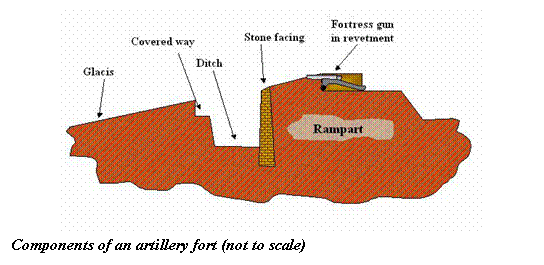 Forts became increasingly complex with a range of features such as bastions, ravelins, hornworks, lunes, demi lunes, capionnieres and so on. Groups of forts providing interlocking and supporting fire zones were built The heyday of fort building in Europe was the period between 1650 and 1750, some WW1 forts were originally built in this period (and later updated). Over the 19th century the fort evolved considerably in response to changes in military technology. Existing forts were modified (or rebuilt) and new ones constructed to cope with these changes and it is these new or modified forts that represent the bulk of those encountered in WW1. The basic underlying structure did not change although new materials such as steel and concrete might be used.  A key factor of change was the introduction of effective overhead fire. The system of glacis, ditch and rampart provided protection against fire from heavy siege guns, field artillery and rifle fire alike but did not provide overhead cover. At first this was not a problem as it was extremely difficult for armies to transport mortars or howitzers sufficiently large (and therefore very heavy) to pose a problem for the fortress garrison. This was not always the case if the fort was near navigable water. The Royal Navy’s bomb ketches were specifically designed to carry large (usually 13 inch) mortars. Grant was able to use river transport to bring up heavy mortars for the siege of Vicksburg. Big though they were, the gunpowder charge in the bombs or shells fired by such weapons was not powerful enough to cause serious structural damage to the ramparts of the fort. However bursting either over or in the often confided space behind the fortress walls they could be devastating killing gun crews and infantry alike, overturning guns and exploding magazines. At Vicksburg and elsewhere the Confederate defenders had to hurriedly construct bomb proof shelters and overhead cover for the guns in their revetments. These took the form of log roofs covered in earth (much like a WW1 dugout). The need for such structures increased as the spread of railways and the use of steam traction engines allowed armies to deploy such heavy weapons and increased the pressure for protection from overhead fire. By the 1870s stone (or concrete) and earth structures had replaced the old log and soil bomb proof shelters. Some forts were completely roofed in whilst in others as much as possible (such as magazines) was placed in underground chambers or passages. Forts had never been particularly pleasant places in which to live, even in peace time, but now they were often dank and dark. They were also frequently unsanitary; many French forts did not have lavatories until 1917 or later. The development of more powerful guns and high explosive shells in the last part of the 19th century also changed the fort. Guns poking over the parapet or out through gun ports or embrasures were unlikely to survive for very long, even if they did not receive a direct hit a near miss would send showers of stone fragments and shell splinters through the post to scythe down the gun crew. The old heavy fortress guns that recoiled on wheeled carriages were replaced with larger and more powerful rifled artillery, often mounted on disappearing gun carriages. These carriages allowed the gun to fire over the top of the rampart and the recoil would carry the gun backwards and downwards raising a large counterweight. The gun could be loaded in safety behind the thickness of the rampart, a catch released and the counterweight would raise the gun back up to its firing position. 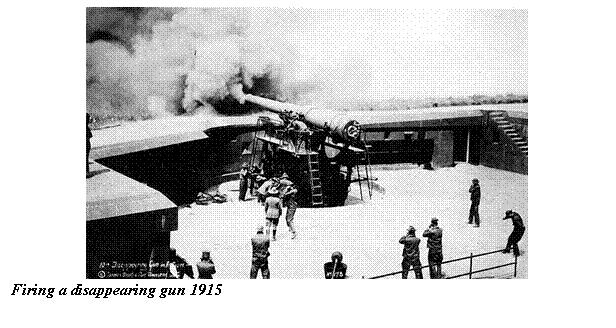 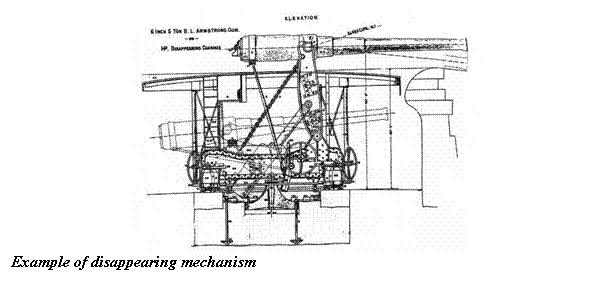 The disappearing gun was still vulnerable to overhead fire. Various solutions were attempted by producing hinged armoured lids that could be fitted to circular pits housing disappearing guns. These lids would lift as the gun was raised for firing and close as it recoiled back and down. The problem with this approach was the danger that relatively slight damage might jam the lid thus putting the gun out of action. Simpler approaches including mounting the guns behind sliding port covers made of very thick iron or reinforced steel. Krupp even designed a system wherein the gun was housed in a heavy steel casemate, the muzzle of the gun was of spherical shape and this fitted into a socket in the casemate. There was no recoil mechanism, as it could not move backwards without dragging the whole mass of the fort with. Some fortress guns were housed in huge steel turrets much like land locked battleships. As an added refinement some were designed to be retractable. In practice the more complex turrets were prone to jamming or other mechanical failure putting the gun out of action. Smaller guns (intended as anti personnel weapons) could be housed in steel revolving turrets or fixed concrete ones in which the gun itself could be traversed to cover a wide arc. Some gun turrets would be mounted on rails to allow them to be moved from position to position (and conceal their whereabouts from the enemy).  The increased power of shells available to besiegers was countered by a greater use of steel and concrete. The stone face of the ramparts might be replaced or reinforced with thicker concrete. Earthen features might be replaced with concrete structures. When some of these forts were engaged in 1914 it was found that insufficient attention had been paid to reinforcing overhead structures as the super heavy German and Austro Hungarian howitzers could deliver plunging fire that could punch right through much of it. The machine gun added yet another dimension and arrangements varied from the addition of simple machine gun positions, sometimes dug in the glacis or placed in outworks, to steel machine gun turrets embedded in the main concrete structure of the fort. Concrete machine gun pill boxes were used.  Forts in World War One Different countries had different attitudes to forts and this in turn conditioned where they were built. Britain tended to trust to the Royal Navy to protect the island from invasion. As a result apart from some coastal fortifications and batteries to protect naval installations Britain had no modern forts. Germany followed Moltke’s dictum “build railways not forts” so that apart from Tsing Tau in China Germany’s forts were designed to protect naval facilities. The USA had a series of powerful coastal forts some with big howitzers and mortars designed to bring plunging fire onto the less protected decks of attacking battleships. Forts were built in a number of locations in the Ottoman empire, including the approaches to Constantinople (yet to be renamed Istanbul) and the Dardanelles. Turkish Forts were often a little behind the times lacking overhead cover. 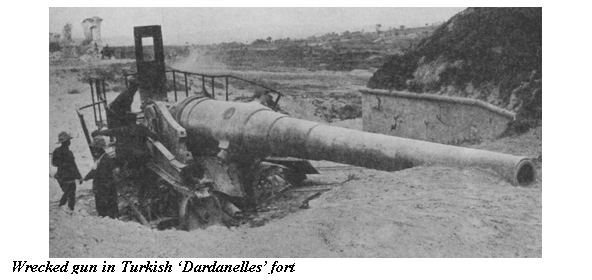 They could still be effective, succeeding in holding off an Allied (French and British) fleet attempting to force the strait (although they were down to less than 30 minutes worth of ammunition when the attack was called off at the behest of the French admiral; had the Allies persisted there would have been no need for the Gallipoli campaign and Turkey might even have been forced out of the war.) The forts also proved a serious obstacle to some of the Gallipoli landings. Elsewhere Turkish forts were a ‘mixed lot’. Forts were scattered all over the Middle East but most were stone constructions designed to keep out tribesmen armed with muzzle loading muskets (much like the infamous French Foreign Legion forts of the Beau Geste era); a single field gun would be their downfall. Many are still there today having played little or no part in WW1 (the one at Huf Huf in Saudi is particularly impressive as an example of its kind). Only the fort at Fao guarding the port of the same name at the top of the Arabian Gulf proved to have more than a token impact. It barred the way to British landings on November 6th 1914 but once heavy artillery was brought up on Nov 8th its walls were breached and a storming column went in, taking the fort in about five hours fighting; the way to Basra was clear. Elsewhere in places such as Ziaret (in modern Georgia) that had seen many conflicts between Turkey and Russia the forts were in a more modern condition. The Turkish forts at Erzerum protecting the approach to Western Armenia had combined garrisons of well over 15,000 and mounted over 300 artillery pieces. They were upgraded with German assistance and only taken by the Russians in February 1916 after six days of heavy artillery bombardment and infantry assaults.  The Turkish military command regarded the fall of Erzerum as far more significant than that of Baghdad. Russian history is littered with sieges and dogged Russian defences (not always successful); Sebastopol and Port Arthur being two such events. The destruction of the forts protecting Port Arthur by Japanese super heavy guns could be said to have been a portent for fortresses in Europe inWW1, however many military officers at the time regarded the Russo Japanese war as a sort of mildly interesting oddity “ not really our kind of war” as one British officer is said to have remarked. Forts were scattered throughout the Russian Empire but a great many were very much in the mould of the Turkish forts designed to hold down conquered khanates in Central Asia and elsewhere rather than to be serious defences against modern artillery (18th and 19th century Russian forts were even built in Alaska, California and Hawaii). More modern forts included the small Russian fort of Osoviec, on the Niemen front that played a key role in foiling an attempt by Hindenburg to break through in 1915. Austro Hungary (KuK) was a builder of forts to protect vital cities, water ways and strategic approach routes. Some of these were very old but had been continuously updated. One of these was Przemysl (now in modern Poland) in the Carpathians which successfully withstood a brief assault in September 1914 by forces under the command of Radko Dimitrieff, a Bulgarian general in Russian service, and was then attacked by the Russians under General Selivanovin November of that year. The besieging army had a force 72,000 whilst the garrison numbered some 170,000. Moreover the Russians had no siege artillery (siege guns sent to Selivanovin had been diverted by him to the defence of Fort Osoviec). The Russian contented themselves with loosely investing Przemysl and foiling the garrison’s attempts to break out or to disperse his force. Selivanovin was baiting a trap. Przemysl was regarded in the KuK much as Gibraltar was in Britain, it could not be allowed to fall! The only routes for the relief of the fortress were through passes in the Carpathian Mountains, at this time of year these were snow bound and also under the control of the Russian General Brussiloff. Throughout the winter of 1914/15 the KuK army attempted to force the passes suffering substantial losses, the majority of which were caused by the winter conditions. In March 1915 Selivanovin recalled his siege artillery from Osoviec (Hindenburg having failed to break through) and increased his forces to 750,000. The big guns made short work of the outlying forts. 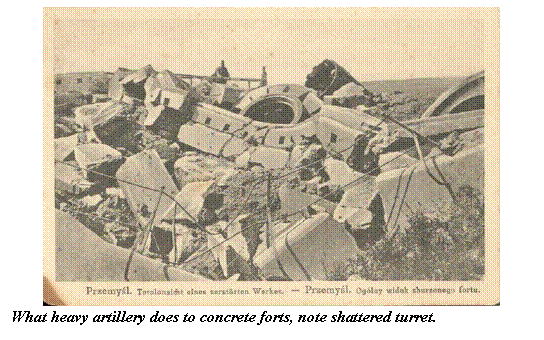 A final attempt by the garrison to break out on 21st March was routed. Some of the garrison appear to have mutinied and the fortress fell the following day. Its loss was said to have had a bigger effect on morale in Vienna and Budapest than any strategic impact. Both the Italian’s and the Austrians maintained a series of forts on the Trentino Plateau in what was called the Alpine barrier. The two lines of forts were about 12 miles apart. Both Italian and Austrian forts were very similar constructions of very thick concrete in which were mounted immense cast gun cupolas. These were supposed to be able withstand a direct hit from a gun as big as the Skoda 305mm howitzer, generally regarded as a fortress killer (as it turned out they couldn’t).  In March 1916 the KuK launched an offensive across the plateau with the intention of reaching the sea near Venice and isolating the Isonzo front from the rest of Italy. This offensive was called the Strafexpedition being intended to punish Italy for (as the Austro Hungarians saw it) having abandoned its treaty obligations under the old Triple Alliance. The battle lasted three months and the maximum penetration of the KuK forces was about 12 miles. The seven Italian forts played a major part in slowing the enemy advance even though five of them were destroyed in the fighting (one when a 305mm shell passed through the overhead concrete to explode in the magazine). France had been fortress minded for centuries. It was a French engineer Vauban who was the doyen of fort building in the 17th century building a belt of forts along the border between France and what is today Belgium. In 1914 there were modern French forts along both the border with Germany and Belgium. The forts facing Germany were in four clusters. The forts in each cluster had interlocking fire zones. The idea that in the event of was the presence of the forts would channel attacking forces into areas where the French army would defeat them. This theory didn’t quite work in 1914. The cluster around Verdun contained 20 major and 40 minor forts and acted as a shield blocking an advance on Paris. It was a sector that had to be defended at all costs. In 1916 these forts were subject to a massive attack by the German army. The intention was to “bleed France’s army white” as the French could not risk the Germans breaking through to Paris. At the end of the battle both sides had suffered over 400,000 casualties. Part of its effect may have been the French army mutinies in 1917. The Battle of Somme was in great part intended to take the pressure off the French by forcing the Germans to divert forces from the Verdun offensive. In this respect it succeeded but at horrific cost. The story of the ten month French defence of Verdun requires a work of book length. An excellent piece of initial reading on the subject is Alistair Horne’s classic work The Price of Glory.  The French forts facing Belgium although initially built to the same standards as those facing Germany they were neglected all resources being directed to the German frontier. When the German army advanced through Belgium these forts were unable to put up any meaningful resistance. One fort had a garrison of only fourteen men! Belgium had reacted to the successful Prussian invasion of France in 1870 by planning and building a number of forts. These were completed by 1890. The Belgian strategy was not to build on the borders but instead to ring their three most strategic cities with forts so Liege was ringed with twelve new forts and Namur with nine. Antwerp was already fortified; forts having been built to counter a French threat in 1859. These were both supplemented by new building and upgraded. This not only protected the cities but blocked the routes to be taken by any invading army which would not be able to by pass them and leave them to threaten its communications. Given Belgium’s defensive treaty with Britain and it was considered that the forts could hold up and advancing German army long enough for considerable reinforcements to arrive and be deployed. The flaw in this approach, revealed in 1914, was that the forts were not capable to holding the Germans for long enough. This was partly due to an underestimate of the power of the German’s super heavy artillery and their ability to transport and deploy it but the forts themselves had some serious flaws. Not only was the concrete used not reinforced ferro-concrete but also it was poured in layers in a way that left weaknesses in the completed structure. Its three metre thickness proved inadequate. The design of the forts was not unlike those used by the Italians on the Trentino plateau in that the guns tended to be clustered together in a central citadel and fed by a central magazine. A heavy shell penetrating the overhead concrete could blow up the whole fort as indeed one 420 mm German shell did at Fort Loncin. The heavy guns were housed in retractable turrets that proved susceptible to jamming for minor damage or even just plain mechanical failure. Worse still the forts did not have mutually supporting and interlocking fire zones. This not only meant that they could be more easily picked off one by one but also that enemy soldiers could easily pass through the spaces between the forts. In 1914 the forts at Namur were subdued in four days whilst at Liege the German army was able to slip past the forts to take the city and wait for their siege artillery to catch up with them. When it did the forts were subdued almost as quickly as at Namur. Alone and isolated Antwerp was doomed to fall.  |
| Sponsored Links |


|